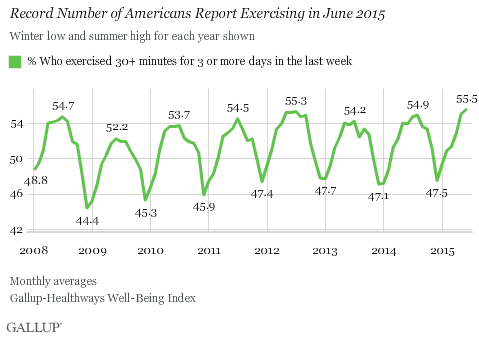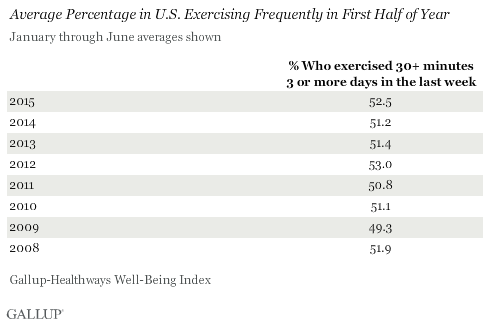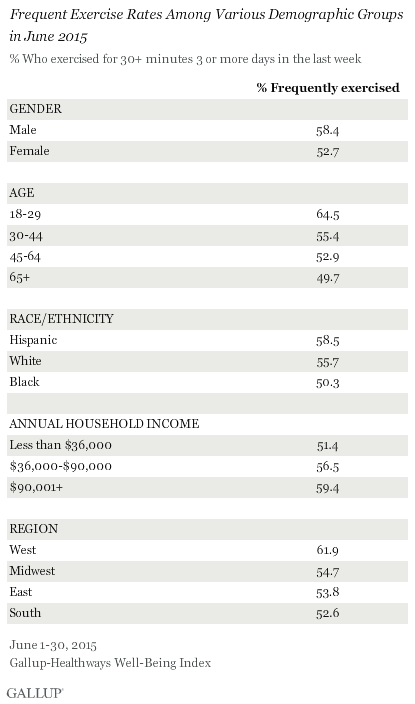Story Highlights
- 55.5% of Americans exercised three or more days in last week
- Highest monthly average in seven years of tracking
- Hispanics, young adults and men more frequent exercisers
WASHINGTON, D.C. -- More Americans are exercising consistently each week, with 55.5% indicating frequent exercise in June 2015, more than in any month since Gallup and Healthways began tracking this metric in January 2008. In every month this year, more Americans reported exercising for at least 30 minutes three or more days per week than in the same month for the past two years, indicating that Americans' exercise habits may be improving in 2015.

Gallup and Healthways ask at least 500 American adults each day about their exercise frequency. Specifically, these Americans are asked to report how many days in the last seven they exercised for at least 30 minutes.
Exercise follows a seasonal trend in the U.S., with more Americans saying they work out in the summer and less in the winter. The difference in frequent exercise during summer and winter months is typically about seven percentage points.
In the first half of the year, on average, 52.5% of Americans reported exercising for at least half an hour on three or more days of the previous week. This is slightly below the average of 53.0% for the first half of 2012, but up from the same time period in 2013 and 2014, making 2015 the second-highest year-to-date average in this survey. The lowest average occurred in 2009, when 49.3% of Americans reported exercising frequently in the first half of the year, the only time this average has been below 50%.

Frequent Exercise More Common Among Men, Hispanics and Young Adults
June 2015 reports of frequent exercise vary by demographics. Men are more likely than women to report exercising frequently. Younger adults, aged 18 to 29, are significantly more likely to exercise frequently than those who are older. And Hispanics are slightly more likely to report exercising frequently than whites, and much more likely than blacks.
Among income groups, upper-income Americans are the most likely to exercise frequently, and lower-income Americans are the least likely. Americans who live in the West are more likely to exercise than those in any other region, while those in the South are the least likely. These trends have been consistent over time.

Implications
While frequent exercise seems to dip in the fall and winter, if the current trend continues, 2015 may be one of the best years for exercise rates in the U.S. Research shows that even small improvements in Americans' exercise habits have a positive effect on population health in general, and weight loss and lower obesity rates for individuals more specifically.
Beyond combating weight gain, exercising frequently has many other benefits. Previous Gallup-Healthways research shows that frequent exercise is linked to having a more positive body image and improved emotional health, especially among low-income Americans. Additionally, Americans who set and achieve exercise goals can develop a stronger sense of purpose. And exercising with family and friends can help boost social well-being.
Given these benefits, local leaders may want to encourage frequent exercise as a priority. Some of these interventions could include creating bike paths, improving lighting so residents can exercise safely at night and holding community events that encourage exercise.
Survey Methods
Results are based on telephone interviews conducted June 1-30, 2015, as part of the Gallup-Healthways Well-Being Index survey, with a random sample of 14,683 adults, aged 18 and older, living in all 50 U.S. states and the District of Columbia. For results based on the total sample of national adults, the margin of sampling error is ±1 percentage point at the 95% confidence level. All reported margins of sampling error include computed design effects for weighting.
Each sample of national adults includes a minimum quota of 50% cellphone respondents and 50% landline respondents, with additional minimum quotas by time zone within region. Landline and cellular telephone numbers are selected using random-digit-dial methods.
Learn more about how the Gallup-Healthways Well-Being Index works.

